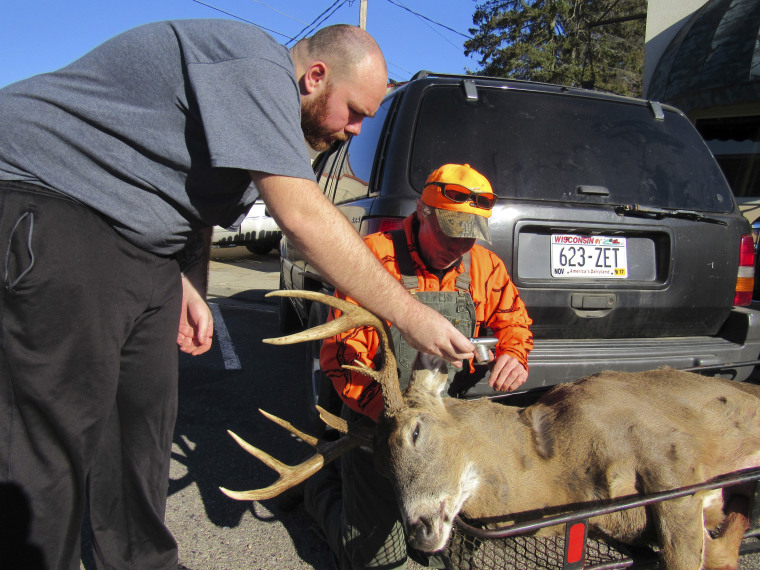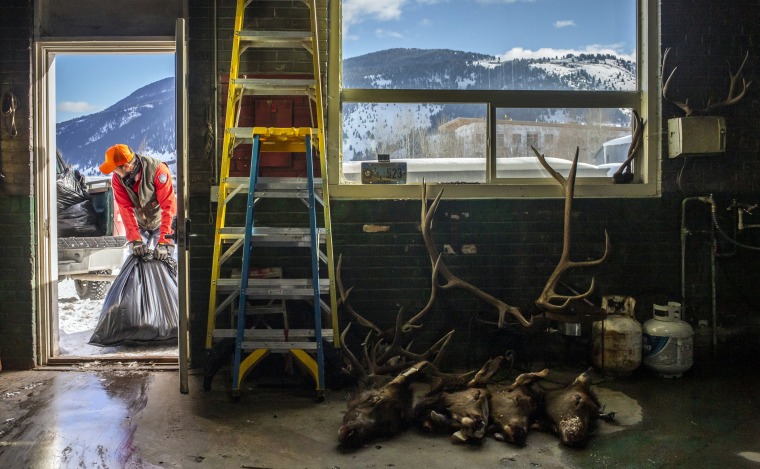Doug Duren lives on a 430-acre farm in Wisconsin that’s been in his family for 115 years, and he keeps more than 200 acres of it wild for deer hunting.
It’s a vast plot of land to hunt on — boasting around 75 white-tail deer per square mile — and Duren, 60, keeps in mind a conservationist mantra when he manages it: “It’s not ours, it’s just our turn.”
That phrase is of particular importance these days for hunters like Duren, as a sickness called chronic wasting disease (CWD) continues to spread through the cervid population, which includes animals like deer, elk and moose.
Duren has dealt with it on his land. Three of the 30 deer killed on his property this past season tested positive for CWD, and he’s growing worried as the disease has now been found in 24 states across the country.
“From a hunting perspective and a public health perspective, will we be okay with the fact that a majority of our deer are walking around with a disease that is going to kill them in two years?” he asked Saturday after returning home from a nearby fishing competition.
Now many experts are also worried that the disease could transfer to humans through consumption of deer meat. Michael Osterholm, director of the Center for Infectious Disease Research and Policy at the University of Minnesota, told state lawmakers this past week that he's concerned that might happen soon.
"It is probable that human cases of chronic wasting disease associated with consumption with contaminated meat will be documented in the years ahead," he told the Minnesota legislature last week. "It’s possible the number of human cases will be substantial, and will not be isolated events."
Often compared to mad cow disease, the affliction comes from a form of protein called a prion, which collects in the animal’s brain and lymph nodes. The disease is always fatal, according to the Centers for Disease Control and Prevention, but prior to death it can cause animals to lose weight and coordination and make them grow in aggression.
Right now concerns about CWD within the hunting community seem to be largely limited to people who are dealing with it in their hunting area.
But a slew of headlines published shortly after Osterholm’s testimony warned of a “zombie deer” disease that could soon infect humans, which Duren and many other hunting advocates and educators said is less than helpful.
Steven Rinella, a wild game cookbook author who operates the MeatEater Podcast and the Netflix television series that boasts the same name, called the misrepresentation of the disease over the past week “one of the worst cases of clickbait appeal.”
“It’s always unsettling when something like this catches on in the mainstream media and it gets grossly misrepresented and it doesn’t take into account all the expertise that’s been applied to this,” he said.
Though Rinella, 45, wasn’t a fan of the recent coverage, he said he is very concerned about the disease and has watched it spread across the country over the course of his entire career. This disease isn't new, he points out: The first case was found in Colorado in the 1960s and grew considerably in the early 2000s.
Today, Rinella, like Duren, says that testing is part of the hunt.

“Right now concerns about CWD within the hunting community seem to be largely limited to people who are dealing with it in their hunting area,” Rinella said. “People wake up to it when it hits close to home. I would like to see a greater degree of concern coming from hunters who are in areas that are not yet affected.”
Because of the continued spread of the disease, state agencies are remaining vigilant and many are setting up locations where hunters can drop off deer heads to be tested for the disease. They receive results in seven to 10 days.
Keith Stephens, the chief communications officer of the Arkansas Game and Fish Commission, said that his state maintains 35 drop-off locations across the state where hunters can wrap up their deer heads in plastic, attach a note and place them in a freezer. They are also working with taxidermists and educating hunters at every opportunity.
But the amount of tests they are conducting free of charge for the state’s hunters is costly, especially because they have to send everything off to be tested in Madison, Wisconsin. Some states have their own testing facility.
Would you feed that meat to your 4-year-old knowing it could be infected?
“The individual test is not expensive but we’ve tested almost 19,000 deer since 2016,” Stephens said. “I think it’s about $20 a piece, so that adds up. But we feel that it’s important to make sure hunters are comfortable to consume the deer in Arkansas.”
Some states have invested in creating bounty programs to diminish infected deer populations, and others have poured dollars into further research to find a cure or any form of solution. But it all requires money.
While the federal government invested millions of dollars to study chronic wasting disease after declaring a state of emergency in 2001, that money ebbed in ensuing years and has not been reinvested. The Department of Interior declined to comment.
Sen. Amy Klobuchar, one of the Democratic presidential contenders, pushed Congress for federal funding late last year.
The decline in funding is a problem for many hunters because they say there is so much they don’t know about CWD and whether it can spread to humans.
“The hardest part is that there are so many unknowns,” said Jeff Minsterman, who hunts near his home in Pennsylvania. “They haven’t proven that it has happened but at the same time would you feed that meat to your 4-year-old knowing it could be infected?”
Rinella said following the science and investing in research is key.
“I would think any federally elected officials from any state where there is a deer hunting culture should be paying a lot of attention to this,” Rinella said. “There is a huge industry for rural communities around deer hunting and there are some potentially big public safety concerns.”
There has been some fresh movement on that front.
Sen. John Barrasso, R-Wyo., was joined by a bipartisan group of senators from across the country to introduce a bill earlier this month that directed the Department of Agriculture and the U.S. Geological Survey to work with the Academies of Science to further study the disease.
The bill would enlist the groups to provide a study in 180 days, and all of it would be paid for by USDA and the Department of the Interior.
The study is welcome to hunters and beleaguered states, as people who participate in the trade say that CWD puts a popular American pastime in jeopardy.
Deer hunting attracted more than 8.1 million hunters in 2016, according to a 2016 Census and U.S. Fish and Wildlife Service study. Collectively those individuals spent nearly $15 billion on travel and equipment, which has helped float a major American industry and many rural towns.
There is a fear, however, that the hysteria around CWD could affect whether people travel or purchase certain products.
“I can see it decimating sporting goods stores and some companies because people don’t come, they don’t buy the equipment and it’s hard to watch that and not know if that’s a solution,” said Minsterman, who is a regional sales manager for a sports optics company.
Still, it is difficult to ignore the potential health concerns because of how closely intertwined eating and hunting are.
An outdoor recreation and natural resource research firm called Responsive Management found in 2017 that 39 percent of hunters pursue the sport for the meat. An Alliance for Public Wildlife report from March 2017 said that it is estimated that up to 15,000 hunter families eat CWD-infected meat every year. The report said that number grows annually by as much as 20 percent because of the spread of the disease.
“Thankfully no one has ever contracted the disease from eating CWD-positive venison, but I'd love to have a crystal ball to see if that’s still the case or not in 25 years,” said Rinella, who gets his animals tested after hunting in infected areas. “The uncertainty is tough.”


